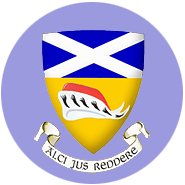
Flags
All heraldic flags in Scotland, and the regulations governing their dimensions and display, come under the legal jurisdiction of the Lord Lyon, King of Arms.The Ensign
An ensign may occasionally be granted and blazoned. This is a square flag, smaller than the flying banner, and carrying the full embroidered achievement (arms, crest, motto), again fringed in livery colours. Some experts regard this as an over-elaborate object, flying in the face of the principle that good heraldry is simple heraldry, but it can be very decorative in an indoor setting.
The Pipe Banner
A flag with a practical purpose is the pipe banner, which can carry either the arms or the full achievement with crest and motto. This type of banner is often handsomely embroidered and fringed in the livery colours - sometimes backed with the family tartan, sometimes embroidered on both sides - and is borne by the baronís pipers or by the pipe major of a pipe band to which he has given his sponsorship. By tradition, a baron parades two pipers on his ceremonial occasions. The pipe banner is an awkward shape, the top running upwards parallel with the largest drone, and artistically it may be difficult to display the arms over the entire available surface without impossible distortions, but when well displayed a good pipe banner is one of the truly effective uses of modern heraldry.
Pipe banners are normally designed to hang down from the drone so that the 'hoist' (a term appropriate to flags and used to describe the edge of a flag nearest the flagpole) is at the top and the 'fly' (the opposite edge to the hoist) below.
They are generally made of silk, finely embroidered with silk or metal thread and fringed with the livery colours of the arms.
Unlike most other flags a pipe banner has two distinct sides, the 'obverse' and 'reverse'. To display the banner to advantage when pipers are playing at table they should start in a clockwise direction (the pagan ritual of turning with the sun) displaying the obverse to those sitting in the centre. They will later change direction to display the reverse.
Sir Thomas Innes of Learney, as Lord Lyon, specified that the arms as displayed on the 'shield' be spread across the entire surface of the banner in the same manner as the flying banner.